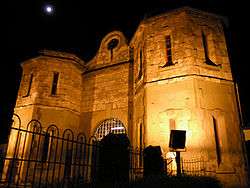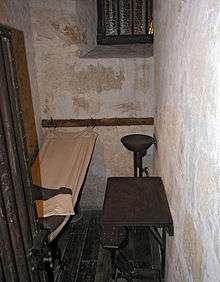Punishment in Australia
The Australian prison system is a part of the Australian criminal justice system. As of 2014, 51% of Australian prisoners were convicted of a violent crime. [1]
Prisons in Australia are operated for the detention of minimum, medium and maximum-security prisoners convicted in state and federal courts. There is no separate federal prison infrastructure. There are 85 prisons in Australia that are government operated prisons, nine privately operated, four transition centers, twelve court cell centers, and one periodic detention center. There are also many former prisons that are now open to the public as museums.
At 30 June 2015, the number of imprisoned adults in Australia was 36,134, making the national imprisonment rate of 196 prisoners per 100,000 adult population.[2]
Since 2015, the number of imprisoned adults in Australia increased to 41,202, a 6% increase since 2016, with 208 prisoners per 100,000 adults imprisoned.[3]
The female imprisoned population in Australia is 8.1 percent of the total adults that are incarcerated. The percentage of the total female prison population has risen 1.7 percent since 2000. In the year 2000 there were 1,385 female prisoners, in the latest recount in 2017 there were 3,333 female prisoners. The female prison population rate is calculated based on the national population total, making the female prison population rate 13.5 per 100,000 of the national population. Although women are still a very small proportion, their percentage of the prisoner population has grown significantly over the past decade. The increase in Indigenous women prisoner's accounts for most of that growth. The increase in Indigenous women prisoners is due to a higher number of Indigenous women entering prison again for re-offending, as well as increased policing and tougher sentencing. [4]
History
New South Wales, as the founding site for English settlement in Australia in 1788, has had prisons for as long as Australia has had European settlement. The first Australian colony was founded at Port Jackson (now Sydney) on 26 January 1788, and marked the commencement of many decades of convict arrivals from the United Kingdom.
Life imprisonment in Australia
In Australia, life imprisonment is of indeterminate length. The sentencing judge usually sets a non-parole period after which the prisoner can apply for release under parole conditions, or in the case of a criminal who has committed particularly heinous crimes, the sentencing judge may order that the person is "never to be released".

Capital punishment in Australia
Capital punishment had been part of the legal system of Australia since British settlement and during the 19th century, crimes that could carry a death sentence included burglary, sheep stealing, forgery, sexual assaults, murder and manslaughter and there is one reported case of someone being executed for "being illegally at large" and during the 19th century, these crimes saw about 80 people hanged each year throughout Australia.
The death penalty was abolished in Queensland in 1922, Tasmania in 1968, the Commonwealth in 1973, Northern Territory in 1973, Victoria in 1975, South Australia in 1976, ACT in 1983, Western Australia in 1984, and New South Wales in 1985. It was finally abolished through federal law in 1973 with the Death Penalty Abolition Act 1973 of the Commonwealth abolished the death penalty for federal offences. It provided in Section 3 that the Act applied to any offence against a law of the Commonwealth, the Territories or under an Imperial Act, and in s. 4 that "[a] person is not liable to the punishment of death for any offence".
No executions were carried out under the bridge of the federal government and the passage of the Death Penalty Abolition Act 1973. Convicts saw the death penalty replaced with life imprisonment as their maximum punishment.
Department for Correctional Services
The Department for Correctional Services is an important part of the justice sector in Australia – responsible for prisoners, the offenders in our communities, and the provision of the rehabilitation opportunities. Their vision is to create a safer community by protecting the public and reducing re-offending. A great emphasis on rehabilitation and reducing re-offending is a major goal of this department. A lot of programs are offered to the prisoners, for example, smoke free programs, alcohol abuse programs, drug rehabilitation programs, etc. Like most prisons, behavior will affect their access to privileges. [5]
Private prisons
Australia is the second country after the United States to outsource corrective services and has since proved that it can be done effectively. The article, "Doing Well and Doing Good: The Case for Privatising Prisons" by Anastasia Glushko displays the positive findings of privately owned prisons in Australia. Private prisons in Australia have decreased the costs of holding prisoners and increased positive relationships between inmates and correctional workers. Outsourcing prison services to private companies has allowed for costs to be cut in half. Compared with $270 a day in a government-run West Australian jail, each prisoner in the privately operated Acacia facility near Perth costs the taxpayer $182 .[6] Also, positive prisoner treatment was observed during privatization in Australia by including more respectful attitudes to prisoners and mentoring schemes, increased out-of-cell time and more purposeful activities.[6] As Australia’s prison population has grown and existing facilities have aged, public-private partnerships have provided opportunities to build new correctional centers while enabling governments to defer much needed cash flow. Australian private prisons are also concerned about what happens to its prisoners after they are released. For example, at Ravenhall Prison in Victoria, Australia, the operator is compensated on the basis of the recidivism rate.[7] This strategy will make the operator more concerned about the wellbeing of its inmates after prison which in return will benefit the entire Australian correctional system.[8]
The Ravenhall Prison completed construction in October 2017 and cost $670 million to build. Due to the steady increase in recidivism rates across Australia, many correctional centers are offering incentives to any institution which can show reductions. The privately owned Ravenhall Prison is offering it's operators a cash payment of up to $2 million in any one year if they reduce recidivism at the prison by 12 per cent in that year, recidivism rates are currently at 39.4% in Victoria. The governmental corrections budget grew in the previous five years to the Ravenhall project from $600 million to $1.1 billion, greater than any other department, including health and education. Recividism rates are not significantly different across private and public detention centers.
Community-correctional orders, on the other hand, are not only significantly cheaper than the cost of private or public incarceration (roughly 10% of the cost of putting people behind bars), but they produce far better long term results, "16 per cent of offenders who completed a CCO returned to corrective services within two years" compared to the nearing 50% in traditional prisons. Community-correctional orders CCOs are increasingly commonplace in Victoria and act as proof that there are real ways in which crime rates can be meaningfully affected, but our current social climate of stricter legislation and service gaps means large-scale prisons are still necessary for now.[9] The following prisons in Australia are managed by private corporations.
Prison museums

Former Australian prisons which are now open to the public as museums.
Former prisons
See also
References
- ↑ ABS, "Prisoner characteristics, Australia", http://www.abs.gov.au/AUSSTATS/abs@.nsf/DetailsPage/4517.02014?OpenDocument. (Aggregate of the categories: "Homicide and related offences", "Acts intended to cause injury", "Sexual assault and related offences", "Dangerous or negligent acts endangering persons", "Abduction, harassment and other offences against the person", "Robbery, extortion and related offences".)
- ↑ Statistics, c=AU; o=Commonwealth of Australia; ou=Australian Bureau of. "Main Features - Key findings". www.abs.gov.au. Retrieved 2018-02-08.
- ↑ Statistics, c=AU; o=Commonwealth of Australia; ou=Australian Bureau of. "Main Features - Key findings". www.abs.gov.au. Retrieved 2018-02-08.
- ↑ World Prison Brief. (2017, September). Australia. Retrieved from http://www.prisonstudies.org/country/australia
- ↑ Services, D. F. (25 October 2017). About us. Retrieved 26 January 2018, from http://www.corrections.sa.gov.au/about
- 1 2 Glushko 2016, p. 21.
- ↑ Glushko 2016, p. 22.
- ↑ Glushko 2016, pp. 32(1), 19-23.
- ↑ CORRECTIONAL SERVICES IN AUSTRALIA|2018|
- Glushko, A. (2016). Doing Well and Doing Good: The Case for Privatising Prisons.